The picturesque ruins of the ancient city of Olympos
The much overgrown picturesque ruins of the ancient city of Olympos are situated at the mouth and on both banks of a torrential stream which flows from east to west into the sea.
 The much overgrown picturesque ruins of the ancient city of Olympos are situated at the mouth and on both
banks of a torrential stream which flows from east to west into the sea. Olympos is around 90 km southwest
of Antalya city near the Town of Kemer.
The much overgrown picturesque ruins of the ancient city of Olympos are situated at the mouth and on both
banks of a torrential stream which flows from east to west into the sea. Olympos is around 90 km southwest
of Antalya city near the Town of Kemer.
The city was founded in the Hellenistic period, presumably taking its name from nearby Mount Olympos or Tahtali Dag in Turkish meaning Timber Mountain. It is one of over twenty mountains with the name Olympos in the Classical world.
 The coins of the city of Olympos date back to the 2nd century BC. Cicero has described it as an ancient city
full of riches and works of art. The city was one of the six leading cities of the Lycian federation. In the
1st century BC, Olympos was invaded and settled by the Cilician pirates until 78 BC when the Roman commander
Publius Servilius Isaurieus, accompanied by the young Julius Caesar, took the city after a victory at sea,
and added Olympos to the Roman Empire. The emperor Hadrian visited the city after which it took the name of
Hadrianopolis for a period, in his honour. In the Middle Ages, Venetians, Genoese and Rhodians built two
fortresses along the coast, but by the 15th century Olympos had been abandoned.
The coins of the city of Olympos date back to the 2nd century BC. Cicero has described it as an ancient city
full of riches and works of art. The city was one of the six leading cities of the Lycian federation. In the
1st century BC, Olympos was invaded and settled by the Cilician pirates until 78 BC when the Roman commander
Publius Servilius Isaurieus, accompanied by the young Julius Caesar, took the city after a victory at sea,
and added Olympos to the Roman Empire. The emperor Hadrian visited the city after which it took the name of
Hadrianopolis for a period, in his honour. In the Middle Ages, Venetians, Genoese and Rhodians built two
fortresses along the coast, but by the 15th century Olympos had been abandoned.
 In the city, in ancient times, the river bed was constructed of regular stones to form a channel. It was
crossed by a bridge one abutment of which has survived. Along the south bank a well preserved portion of
the quay may still be seen. The small steep acropolis lying close to the river mouth bears remains of late and
insignificant buildings but the panoramic view seen from the top of the hill is very beutiful. The small Roman
theater is in poor state of preservation.
In the city, in ancient times, the river bed was constructed of regular stones to form a channel. It was
crossed by a bridge one abutment of which has survived. Along the south bank a well preserved portion of
the quay may still be seen. The small steep acropolis lying close to the river mouth bears remains of late and
insignificant buildings but the panoramic view seen from the top of the hill is very beutiful. The small Roman
theater is in poor state of preservation.
 The most attractive structure is the cella-door (approximately 3x8
meters in size) of a temple which is still in place. From the inscription we understand that a statue of
Marcus Aurelius sttod somewhere in the temple.
The most attractive structure is the cella-door (approximately 3x8
meters in size) of a temple which is still in place. From the inscription we understand that a statue of
Marcus Aurelius sttod somewhere in the temple.
Around Olympos, you can visit the eternal flames of Chimera coming out of the ground, at the neighbouring village of Cirali at about 200 meters above sea level. Also as Olympos village is located in the heart of the Olympos coastal national park the surrounding area offers great conditions for trekking, mountain biking, canyoning, rock climbing, sea kayaking etc. The ancient site is located directly on the Lycian way.
 Today the site attracts tourists, not only for the artifacts that can still be found (though fragmentary and
widely scattered), but also for its scenic landscapes supporting wild grapevines, flowering oleander, bay
trees, figs and pines. The beach also is a lovely one. There are some pensions and budget accomodation in
the national park just in the entrance to the ancient city. Also you can stay at Cirali where it is possible
to rent equipment for activities or to join organized tours.
Today the site attracts tourists, not only for the artifacts that can still be found (though fragmentary and
widely scattered), but also for its scenic landscapes supporting wild grapevines, flowering oleander, bay
trees, figs and pines. The beach also is a lovely one. There are some pensions and budget accomodation in
the national park just in the entrance to the ancient city. Also you can stay at Cirali where it is possible
to rent equipment for activities or to join organized tours.
April 19, 2009
